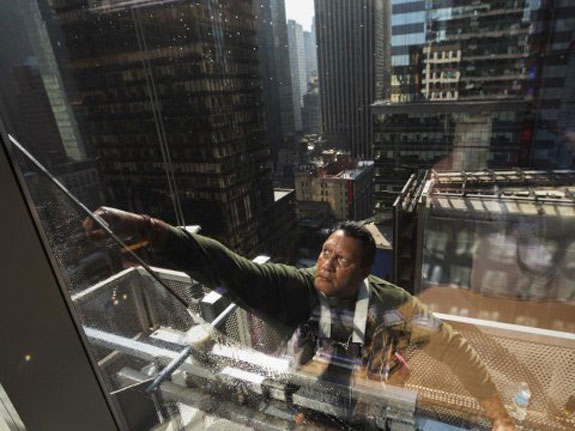Trending
What it’s like to be a Manhattan window washer
Increasingly complex architecture is changing the way washers work

Earlier this week, two window washers were dramatically rescued after being caught dangling from WTC 1. But back in February 2013, Adam Higginbotham of The New Yorker spent some time with window washers at the Hearst Tower on Eighth Avenue in Manhattan to get a sense of what their lives and work are like. Here is what he found.
“Having completed their safety checks, the three-man crew at Hearst climbed into the cleaning basket for their trip down the side of the tower. Bob Menzer stood alone at one end, separated from Brown and Kasparek by one of the unique features of the rig—a cylindrical turret around which either end of the platform could fold toward the other, forming a ninety-degree angle. The boom arm lifted the basket from the roof, forty feet into the air and out over the building’s parapet, and the thirty-six-and-a-half-ton roof car began almost imperceptibly to move along its track toward the corner of the building,” Higginbotham wrote.
“When I went out on the scaffold myself, this proved to be the most unnerving stage of the process: as the basket cleared the parapet, a frigid wind scythed across Columbus Circle, humming in the rigging overhead, and each time I shifted my weight the narrow platform swayed sickeningly, like the world’s most appalling fairground ride. Menzer, resting his elbows on the edge of the basket with the serenity of a man watching ducks on a village pond, controlled each of the rig’s movements using a set of sixteen buttons on a remote-control box. When the car reached the northeast corner of the tower, the basket hung in the air above Eighth Avenue and slowly folded into a right angle. It was ready for a ‘bird’s mouth’ drop.”
One of those drops takes around four hours on an average day, and “given good weather, it takes a month to clean the whole tower from top to bottom.”
Delicate business indeed, and not for the faint of heart.
Higginbotham noted that being a window washer in the US is “significantly safer than driving a cab.”
With that in mind, the danger is real as most of the occupational injuries are from falling from elevation: “Even from thirty feet, only half of those who fall survive.”
Window washer Ron Zeibig told the New Yorker that the “rule is four floors. Two-hundred-pound man, four floors—you’re dead.”
And one added complication these days is the buildings tend to be much more slanted now.
“Years ago, it was just straight up and down, flat glass. Bing! Now everything they’re building is all angles.”




